The good times in Fès come to an end and we are taking the road again. The weather is now fine, legs OK, clothes clean, belly full, and the next step is the Middle Atlas. I have seen snow on TV news about Ifrane, 60 km south of Fès, and it is my destination for the day.
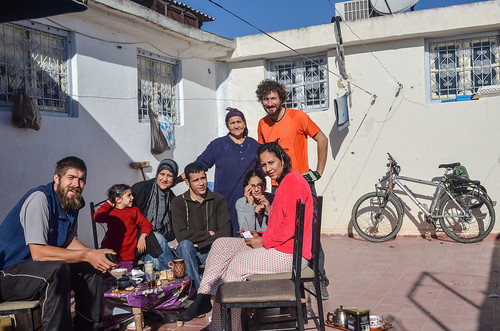
The day starts with the less interesting part, the crossing of the whole city of Fès, second largest in Morocco, to get from the east of the Medina until the south to the airport. The road to Ifrane continues then uphill. Those 10 km in the large avenues get completed quickly and Simon goes his way at the exit of the town.
My road to the airport is busy and dusty. Fortunately, once passed, I can start the ascent to Imouzzer du Kandar in a more quiet environment. The road goes gently uphill.
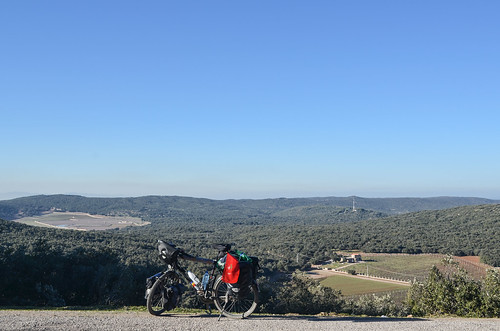
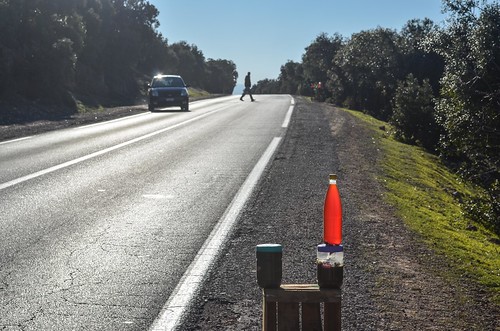
However, once in Imouzzer du Kandar, the traffic starts again, very busy untill Ifrane. This is the last weekend of the school holidays and Ifrane is a popular touristy destination. Drivers are overtaking just in front of me and expect me to jump out of the road. Probably because when Moroccans ride a bicycle, they mostly do it in the gravel by the side of the road and not on the asphalt. I doubt there is a law enforcing the respect of a distance between cars and biycles here …
I don’t remember where from, but I thought Ifrane was 1000 m high, until I see an information sign marking it at 1650 m. That means the descent I was expecting since Imouzzer will not happen. Yet I’m glad to arrive in Ifrane at the end of the day, a very tense day because of the traffic. This was the first time I took a red road on the paper map, a major axis, and I think I won’t do it again.
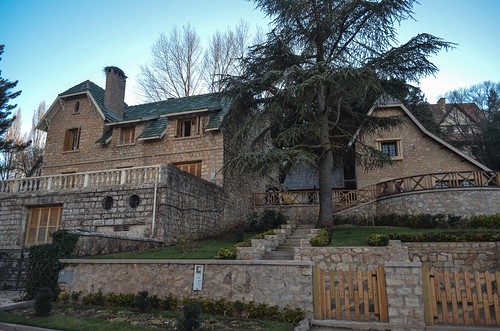
Before heading here, I was introduced Ifrane as the most beautiful city of Morocco, where the houses roof is pointed and tiled instead of a flat concrete bloc like in the rest of the country. It was a hill station during the French colonial era, and it seems that the King, who also has (yet another) royal palace in town, made everything to maintain the atmosphere. Ifrane has cold and snow (and coldest temperature ever recorded in Africa, a warmish -24°C in 1935), which could explain the tiled roofs, but it’s much more about the looks than about being functional.
The 13’000 inhabitants town also hosts the Al Akhawayn University, famous for being the most expensive of Morocco and where international professors come to teach to the children of the richest Moroccans.
So I finally land in this clean city, among nice cars and huge gardens and parks, where people stroll well dressed. My first interaction is with a parking guy wanting to offer me an apartment for 300 dh/night, or even as low as 150 dh/night, which is 3 times the lowest price of any city. He actually tells me that Ifrane people, the locals, are poor, and all what I see is the money flooding from the visiting rich “bandits” of the big cities. And that from Sunday evening, by the end of the holidays, the town will be deserted again.
After the first funny impression, seeing houses that would fit better in Europe than here, I realize that everyone is visiting here. It seems the whole place is a recreational park. There are too many dustbins, prices are the double of the average, and the polite people leave me alone. It’s the less Moroccan-looking place I’ve seen in Morocco.
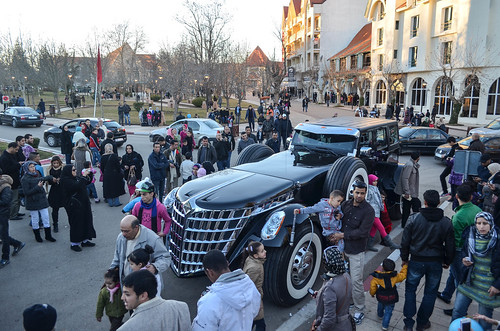
Franklin greets me with a “Welcome to the Switzerland of Morocco”. It is indeed what people say about the town, seemingly arranged for local tourism, and looking like a postcard, with wide roads, huge roundabouts, one-way streets, pine parks all over, and of course patches of snow around the pointed-roof houses. However to me, the shapes are exaggerated and it makes me think more of the village of Snow White or Disneyland. The ratios of the windows width/height and the angles of the roofs look funny. It’s like a habitable theme park.

I am leaving the next day this town of little interest for the foreign traveler for more mountains. I pack breads (the usual khobz selling for 2.50 instead of 1.20) and pass the Royal Palace, watched by at least 5 idle guards at each gate and one more idle guard every 100 m along the very long fence.


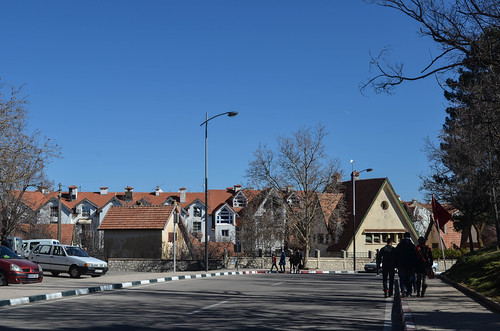
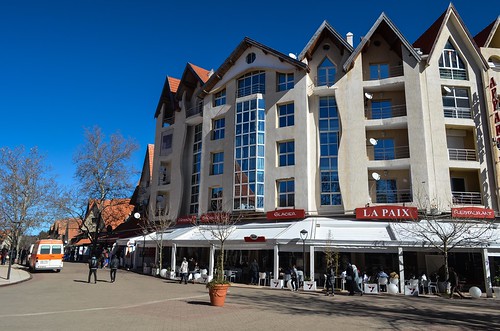
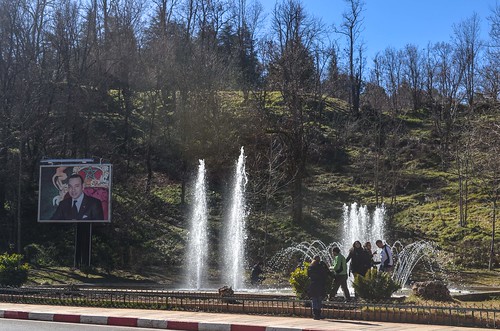
I continue with a rather small road: not the major axis to Azrou, but the narrower one to the ski resort of Mischliffen. It is also a very popular (local) place and I will get a glance of what a ski resort look like here. After all, I have cycled past ski domains in Switzerland and Andorra, and on the very slopes in Spain, so let’s see another one.
The road takes me just below 2000 m, but is incredibly busy. Is everyone going to ski today? I have my answer soon, as I reach a pass with a bit of shade under the trees. Snow has not melted there and tourists can rent sledges to enjoy the 10 meter wide patches of snow.
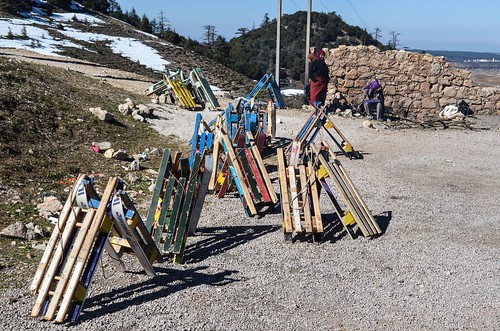
Then I see all the cars parked on the road itself as an extra-wide patch of snow lays on the left hand side, under the pine trees. People are packed into this tiny place to enjoy a bit of ride.

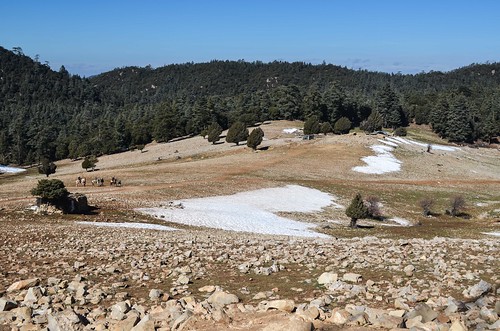
A few kilometers further, the road is jammed as it crosses a forest. It is darker and colder, which conserves more patches of snow. There are sledges and skis for rent all along the road. Among all the people there, I understandably saw only one girl trying skis, and trying to move with it on the flat snow patch. Most of the visitors take a ride down of 10 meters on the sledges. The positive point about the location is that no winter tires are needed to reach it …
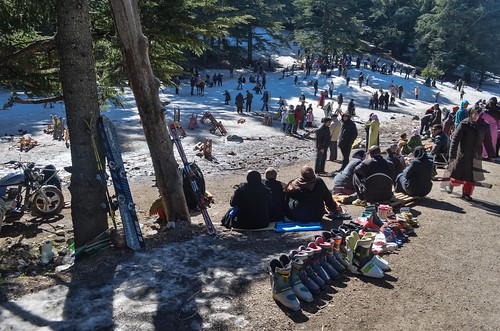


It reminds me of another ski resort in a non wintersports-oriented country, in Manali, India. People could try very old skis on a bit of snow, but at least they had a slope and a ski lift (yet not operating because of a power shortage).
On the way back tot he main road, I finally see a proper ski piste on Jbel Herbi. There is a lift, not operating, and much less people than in the woods.
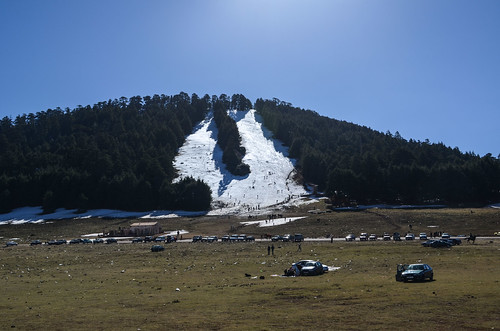
Now, having been to the Drakensberg and Lesotho in Southern Africa, I could say I have visited half of the ski areas in Africa. After this visit of an African winter, I join the main road Azrou-Middelt and it’s really time to take tiny roads: I had, during those 2 days, too many cars driving too close to me.
So I get out of the main roads for a piste. This path should lead me straight to the south as well, but only for me. It starts with patches of snow and sometimes mini-lakes of mud. The area is all of a sudden so quiet.

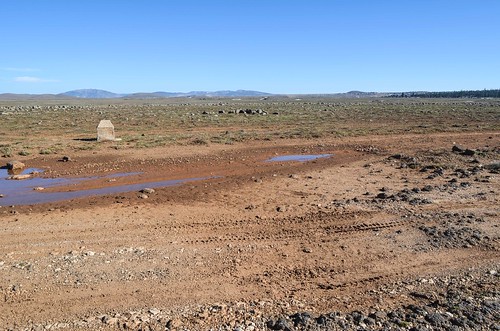
The land is very vast and empty. But it is used, as I end up seeing far away from the track, shacks of herdsmen and flocks of sheep. The piste enters a forest and as I feared it, it is colder and darker: the path is now made of snow and mud. It is ridable, but after a few kilometers taking a while, it makes me feel like returning on the asphalt already. I fall once on a sneaky patch of ice but break nothing.
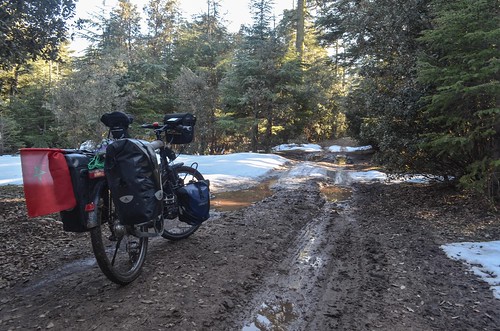
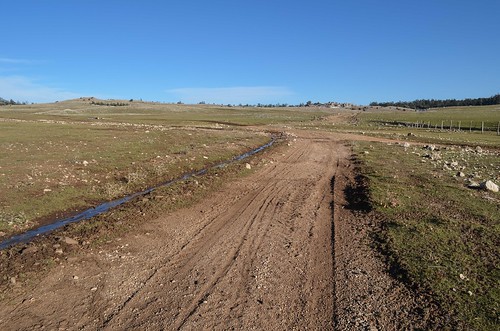
At the end of the day, I finally join again a narrow paved road, going towards Ain Leuh. This short stretch makes me reconsider the crossing of the High Atlas: if it is already bad under 2000 meters, roads may be blocked at 2800 m there. And since there is no one to tell the state of the road or to remove the snow, I will probably be forced to take a major road.
I camp not too far from road. It still looks vast and empty at first, but actually there is always someone or a donkey in my vision field.
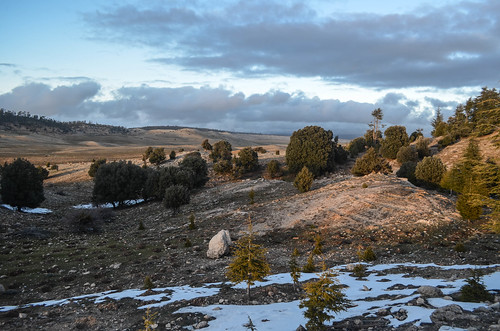






hi thanks for this wonderful aricles, me and my friends would love to visit Ifrane this end of December, However we wanted to make sure that there are enough snow during our trip, when is the best time to travel and experience great snow, Thank you!
Hello, I hope that you’ve passed great time !
For info Ifrane and its region get every winter heavy snow fall… The roof are very useful.
See this : http://www.skyscrapercity.com/showthread.php?t=1269665&page=6
Hello JB!
great to hear everything is proceeding and having a good time!
very interesting to read!
so you are collecting all the Ski resorts of Africa!! you can probably make a book out of it… 😀
all the best and keep enjoying the tour and good luck!!!
ciao LUCA
After the book we’ll see if it convinces you to spend your skiing week in Africa instead of Engadin and Bellinzona …
Greetings from Germany! Enjoy your tour!
Hello settled man!
Salut JB !
Depuis que Claire m’a montré ton blog je guette chaque article, c’est un plaisir de te lire et de suivre tes aventures !
Bon courage pour la suite, profites-en à fond et continue à envoyer tes histoires !
Merci!
Dommage, on s’est loupés a Lyon avec Claire